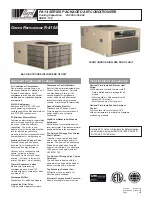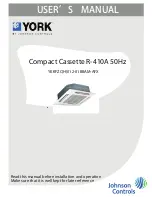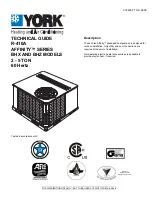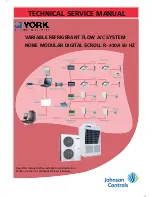
EVD4X, ESD4X, WMVC, WMSC: Installation Instructions
Manufacturer reserves the right to change, at any time, specifications and designs without notice and without obligations.
6
3. Remove fitting door with rubber grommets and slide fitting door
with grommets onto the refrigerant lines (field line-set), away from
braze joints.
4. Fit refrigerant lines into coil stubs. Wrap a heat sinking material
such as a wet cloth behind braze joints.
5. Wrap TXV and nearby tubing with a heat-sinking material such as a
wet cloth.
6. Use 1/2 psig Nitrogen purge in the suction and out the liquid line.
7. Braze using a Sil-Fos or Phos-copper alloy. Do not use soft solder.
8. After brazing, allow joints to cool. Carefully remove TXV bulb
insulation and verify that the TXV bulb is securely fastened with
hose clamp. Tighten screw a half-turn past hand tight with TXV
bulb placed in the indentation with full contact with the vapor line
tube. Re-wrap TXV bulb with insulation.
9. Leak check connections before insulating entire suction line.
10. Slide fitting door with rubber grommets over joints. Position tubing
at center of each grommet to ensure an air seal around the tube.
Reinstall cabinet door.
Refrigerant Metering Device
These Coils have a factory installed hard shut-off TXV designed only for
use with R-410A refrigerant. Use only with outdoor units designed for
R-410A.
NOTE:
These TXVs are factory set at approximately 10° superheat
measured at the suction service valve, and are
not
field adjustable.
These furnace coils use an R410A TXV. The TXVs are preset at the
factory and do not need adjustment for reliable operation. Reference the
outdoor unit instructions to properly charge the unit to the correct
subcooling. Let the system stable out approximately 15 minutes after
each charge adjustment.
Condensate Drain Line Connection
The coil is designed to dispose of accumulated water through built-in
condensate drain fittings. It is recommended that PVC fittings be used
on the condensate pan. Do not over-tighten. Finger tighten plus 1-1/2
turns.
Be sure to install PVC plugs in all unused condensate drain
fittings (if not factory supplied).
Four ¾-inch female threaded pipe
connections are provided in each coil condensate pan.
It is highly RECCOMMENDED and in some locals is it a code
requirement to install a trap on the drain line(s). Please use the following
guidelines to assure proper drainage:
• Install a trap in condensate line of coil as close to the coil as possible.
• Make trap at least 3 inches (76 mm) deep and no higher than the
bottom of unit condensate drain opening (
).
• Pitch condensate line 1 inch (25.4 mm) for every 10 ft. of length to an
open drain or sump.
• Make sure that the outlet of each trap is below its connection to
condensate pan to prevent condensate from overflowing the drain pan.
• Prime all traps, test for leaks, and insulate traps and lines if located
above a living area.
A200230C
Fig. 8 – Condensate Trap
NOTE:
If unit is located in or above a living space, where damage may
result from condensate overflow, a field-supplied, external condensate
pan should be installed underneath the entire unit, and a secondary
CAUTION
!
UNIT DAMAGE HAZARD
Failure to follow this caution may result in damage.
All aluminum tubing and coils must be adequately shielded from any
copper braze splatter.
CAUTION
!
UNIT DAMAGE HAZARD
Failure to follow this caution may result in product damage.
To avoid valve damage to the refrigerant control device while brazing,
valves must be wrapped with a heat-sinking material such as a wet
cloth.
CAUTION
!
UNIT DAMAGE HAZARD
Failure to follow this caution may result in product damage.
DO NOT BURY MORE THAN 36 IN. OF REFRIGERANT TUBING
IN GROUND. If any section of tubing is buried, there must be a 6-in.
vertical rise to the valve connections on the outdoor unit. If more than
the recommended length is buried, refrigerant may migrate to cooler
buried section during extended periods of unit shutdown, causing
refrigerant slugging and possible compressor damage at start-up.
CAUTION
!
PROPERTY DAMAGE HAZARD
Failure to follow this caution may result in property damage.
It is required that all drain connections that are not being used be fitted
with ¾-inch male PVC plugs.
When installing over a finished ceiling and/or living area, install a
field-fabricated secondary condensate pan under the entire unit.
CAUTION
!
PROPERTY DAMAGE HAZARD
Failure to follow this warning could result in
property damage.
Provide trap with air gap in drain line when
connecting to waste (sewer) line.
3
”
(76mm)
Ø1
”
(25.4)
KNOCK-OUT
(IF PRESENT)
SECONDARY DRAIN PORT
(IF PRESENT)
PRIMARY DRAIN PORT (IF PRESENT)
¾
”
(19.05) NPT DRAIN x 4

























